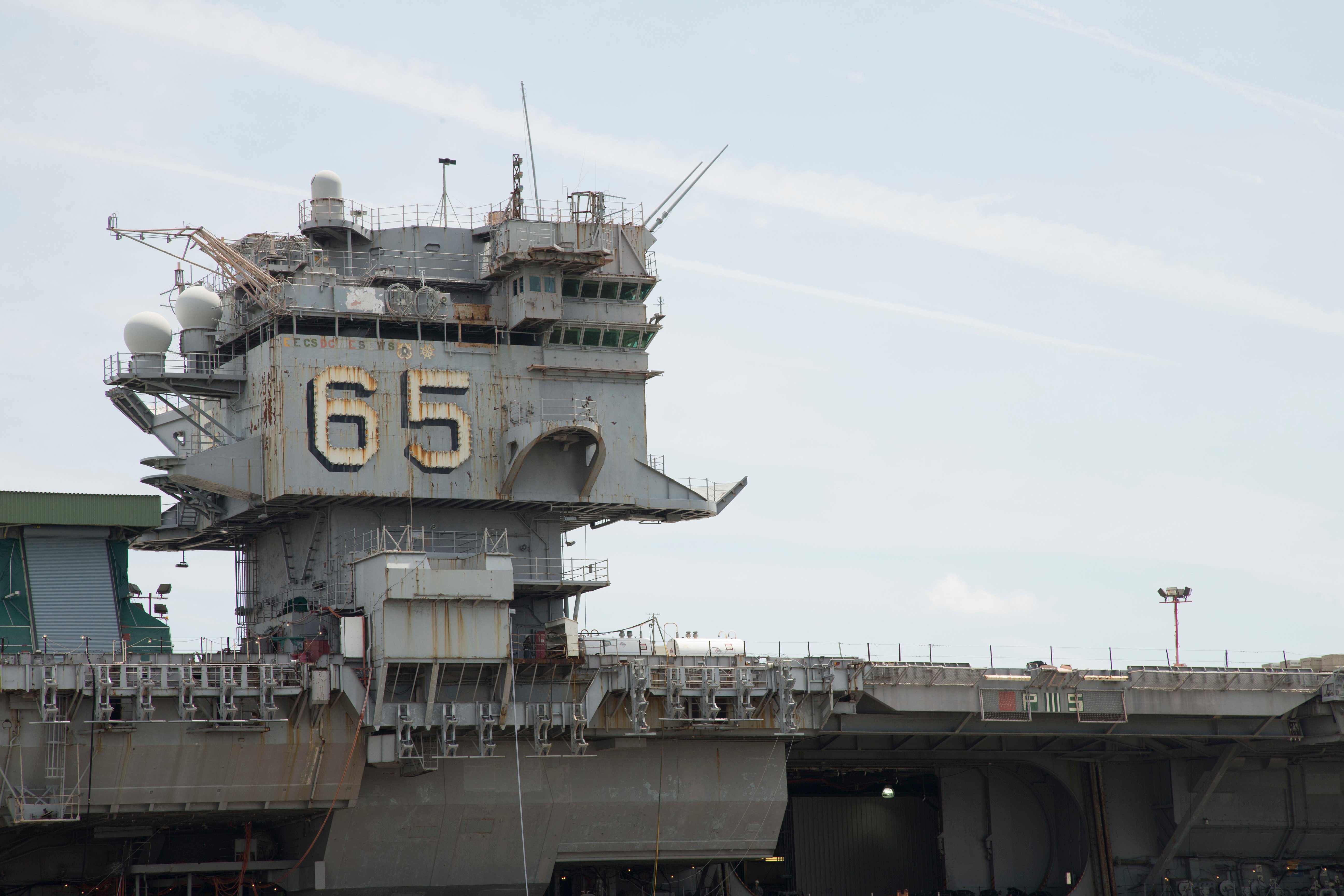Long Beach Aircraft Carrier - An Essex-class aircraft carrier, USS Shangri-La (CV-38) entered service in 1944. One of over 20 Essex-class carriers built for the US Navy during World War II, it joined the US Pacific Fleet and supported Allied operations during the final phases of the island-hopping campaign across the Pacific. Modernized in the 1950s, Shangri-La later served extensively in the Atlantic and Mediterranean before taking part in the Vietnam War. Completing its time off Southeast Asia, the carrier was decommissioned in 1971.
He checked aboard the Kitty Hawk shortly after an engine room fire took the lives of five sailors. The inferno injured at least three dozen others, according to the Naval History and Heritage Command. Shaw said connecting to other R-Division veterans, who were the ship’s primary firefighters, through the Facebook group made him appreciate what those sailors endured in the wake of the tragedy.
Long Beach Aircraft Carrier

“Ships are haunted — they hold the soul of the crew,” he said. “The attachment of a ship and a crew maybe transcends rational thought. You invest your energy, your emotion, your friends, your dead friends ... how many hugely emotional events in a sailor’s life are associated with the crew, with the Kitty Hawk?”
‘Geriatrics For Carriers’
Returning to Ulithi, the carrier embarked Vice Admiral John S. McCain, Sr. in late May when he relieved Mitscher. Becoming flagship of the task force, Shangri-La led the American carriers north in early June and began a series of raids against the Japanese home islands. The next several days saw Shangri-La evade a typhoon while shuttling between strikes on Okinawa and Japan. On June 13, the carrier departed for Leyte where it spent the remainder of the month engaged in maintenance. Resuming combat operations on July 1, Shangri-La returned to Japanese waters and began a series of attacks across the length of the country.
“This was my first ship and there’s a lot of memories,” he said. “In ‘81, just after pulling out of port, I got to hunt my first Russian submarine. I’ve been on several ships and the Kitty Hawk is one of the most memorable.”
Although not the first so-called “supercarrier,” the Kitty Hawk was hailed at the time as the “forerunner of a new and greatly improved line of carriers,” by Adm. Arleigh Burke, then the chief of naval operations.
The most noticeable of these changes was lengthening the bow to a clipper design which permitted the installation of two quadruple 40 mm mounts. Other alterations included moving the combat information center under the armored deck, enhanced ventilation and aviation fuel systems, a second catapult on the flight deck, and an additional fire control director. Referred to as the "long-hull" Essex-class or Ticonderoga-class by some, the US Navy made no distinction between these and the earlier Essex-class ships.

Ship History
While operating in the Atlantic in October 1965, Shangri-La was accidentally rammed by the destroyer USS Newman K. Perry. Though the carrier was not badly damaged, the destroyer suffered one fatality. Re-designated an anti-submarine carrier (CVS-38) on June 30, 1969, Shangri-La received orders early the following year to join the US Navy's efforts during the Vietnam War. Sailing via the Indian Ocean, the carrier reached the Philippines on April 4, 1970. Operating from Yankee Station, Shangri-La's aircraft commenced combat missions over Southeast Asia. Remaining active in the region for the next seven months, it then departed for Mayport via Australia, New Zealand, and Brazil.
“Ships are haunted — they hold the soul of the crew. The attachment of a ship and a crew maybe transcends rational thought. You invest your energy, your emotion, your friends, your dead friends ... how many hugely emotional events in a sailor’s life are associated with the crew, with the Kitty Hawk?”
Transferred to the Atlantic in 1960, Shangri-La participated in NATO exercises as well as moved to the Caribbean in response to troubles in Guatemala and Nicaragua. Based at Mayport, FL, the carrier spent the next nine years operating in the western Atlantic and Mediterranean. Following a deployment with the US Sixth Fleet in 1962, Shangri-La underwent an overhaul at New York which saw installation of new arrestor gear and radar systems as well as removal of four 5" gun mounts.
The world's first nuclear-powered aircraft carrier was commissioned on 25 November 1961 and completed 25 deployments during 51 years of service. Click the links below to access the Dictionary of American Naval Fighting Ships entries for Enterprise, which provide the carrier's history by time period.
Cold War
The Kitty Hawk was the next-to-last U.S. aircraft carrier built to run on diesel fuel. The nuclear-powered Enterprise was launched the same year and the Nimitz was commissioned in 1975, launching a new class of 10 reactor-fueled carriers. Two of them, the Abraham Lincoln and the Carl Vinson, are currently based in San Diego.
The Kitty Hawk would call San Diego home for the next 37 years, before spending its last decade of operations in Japan. It was decommissioned in 2009. For the next 12 years, it would sit with other retired ships in Puget Sound, Wash.

All of the sailors who spoke with the Union-Tribune about the Kitty Hawk said they believed it held a unique place in the Navy compared with other ships that have been lost to the scrapyard. Maybe it has something to do with the sheer number of lives touched by the ship over nearly a half century, directly or through the family and friends of those who served on board.
I’m one of them; I served on the ship as an aviation electronics technician from January 2003 to January 2007, when it was based in Japan. We were always busy and always out to sea and the shared suffering forged lasting friendships among the crew.
A New Design
The first ship to undergo the SCB-125 upgrade, Shangri-La was the second American carrier to possess an angled flight deck after USS Antietam (CV-36). Completed in January 1955, the carrier rejoined the fleet and spent much of the year engaged in training before deploying to the Far East in early 1956. The next four years were spent alternating between San Diego and Asian waters.
Designed in the 1920s and 1930s, the US Navy's Lexington- and Yorktown-class aircraft carriers were intended to meet the limitations set forth by the Washington Naval Treaty. This levied restrictions on the tonnage of different types of warships as well as placed a ceiling on each signatory’s total tonnage. This system was further revised and extended by the 1930 London Naval Treaty. As the international situation deteriorated in the 1930s, Japan and Italy elected to depart the treaty structure.
Jason Chudy, a retired Navy chief living near Seattle, estimates that about 250,000 sailors served on the carrier during its lifespan. Chudy is the membership coordinator for the Kitty Hawk Veteran’s Association, and he was involved in the effort to save the ship from the scrapper.
As is often the case, the men — and, starting in 1994, women — who served on the Kitty Hawk through the years came to see it as home, and many harbored deep attachments long after their service.

Cat And Mouse
Arriving home on December 16, 1970, Shangri-La began preparations for inactivation. These were completed at the Boston Naval Shipyard. Decommissioned on July 30, 1971, the carrier moved to the Atlantic Reserve Fleet at the Philadelphia Naval Shipyard. Stricken from the Naval Vessel Register on July 15, 1982, the ship was retained to provide parts for USS Lexington (CV-16). On August 9, 1988, Shangri-La was sold for scrap.
In November 1952, the carrier arrived at Puget Sound Naval Shipyard for a major overhaul. This saw Shangri-La receive both SCB-27C and SCB-125 upgrades. While the former included major alteration's to the carrier's island, relocation of several facilities within the ship, and the addition of steam catapults, the later saw the installation of an angled flight deck, an enclosed hurricane bow, and a mirror landing system.
The aircraft carrier Kitty Hawk steamed into San Diego in the fall of 1961 with fanfare usually enjoyed by royalty, wrote the San Diego Union’s Lester Bell in a story announcing the warship’s arrival. A swing band on a barge at the mouth of the newly-dredged harbor channel played “California Here I Come,” and fire boats spraying plumes of water escorted it to North Island.
“I’m disappointed San Diego and the Navy aren’t doing something to recognize the Kitty Hawk passing by one last time,” Shaw said. “It’s awesome to be in touch with (other veterans) and know that their time on the Kitty Hawk was meaningful and that we have something in common.”
The Standard Design
The Kitty Hawk’s keel was laid Dec. 27, 1956, at New York Shipbuilding in Camden, N.J. at a final cost of $178 million, or $1.7 billion in 2022 dollars. (Compare that with the $13 billion cost of the Navy’s latest carrier, the nuclear powered Gerald R. Ford.)
“My chief engineer told me once the steam plant on the Kitty Hawk is the most complicated machine ever built or maintained by human beings,” Parker said. “We had a problem finding engineers and were calling people back to active duty to help man the ship. We called it ‘geriatrics for aircraft carriers.’”

The first ship to move forward with the altered Essex-class design was USS Hancock (CV-14) which was later re-named Ticonderoga. This was followed by additional ships including USS Shangri-La (CV-38). Construction commenced January 15, 1943, at the Norfolk Naval Shipyard. A significant departure from US Navy naming conventions, Shangri-La referenced a distant land in James Hilton's Lost Horizons.
The Kitty Hawk’s 48 years of service life spanned 10 presidents and several overseas conflicts. The ship deployed multiple times to Vietnam, fought in the Gulf War and during the War on Terror in Afghanistan and Iraq.
World War Ii
Stephen Sherman, another San Diego Kitty Hawk veteran, worked in the Crash and Salvage division on the ship’s flight deck, the first responders for aircraft fires. On July 11, 1994, an F-14 Tomcat crashed onto the ship’s pitching flight deck, broke in two, and exploded into a fireball.
Shaw was the Repair Division officer from 1974 to 1975. He only spent four years in the Navy. He said he had a low draft number, which pushed him to volunteer for the sea service rather than risk being sent to the jungles of Vietnam.
Construction commenced on the lead ship, USS Essex (CV-9), on April 28, 1941. With the US entry into World War II following the attack on Pearl Harbor, the Essex-class soon became the US Navy's principal design for fleet carriers. The first four vessels after Essex followed the class' initial design. In early 1943, the US Navy requested several changes to improve future vessels.
The two aviators on the jet ejected and landed on the flight deck — one of them in the burning wreckage of the jet. Sherman’s team jumped into action. He manned a fire hose while his fellow sailors pulled the man out of the wreckage. Although he suffered burns, he eventually recovered, Sherman said.

Postwar Years
The name was chosen as President Franklin D. Roosevelt had cheekily stated that the bombers used in the 1942 Doolittle Raid had departed from a base in Shangri-La. Entering the water on February 24, 1944, Josephine Doolittle, wife of Major General Jimmy Doolittle, served as sponsor. Work quickly advanced and Shangri-La entered commission on September 15, 1944, with Captain James D. Barner in command.
So it was that on Jan. 15 the Kitty Hawk was tugged out of Bremerton, Wash., for a slow tow around Cape Horn, Chile, en route to its final, ignominious end: a Brownsville, Texas ship breaker. Its 60,000 tons of steel will be sold off as scrap.
Despite those challenges, the ship was instrumental in the U.S. military response after the attacks of Sept. 11, 2001. The Kitty Hawk, based in Japan, was the first carrier to deploy in support of Operation Enduring Freedom. By mid-October, the ship was in the Persian Gulf operating as a staging base for Army Special Forces. It would again deploy to the Gulf in February 2003 and launched some of the first sorties against Iraq that March.
Completing shakedown operations later that fall, Shangri-La departed Norfolk for the Pacific in January 1945 in company with the heavy cruiser USS Guam and the destroyer USS Harry E. Hubbard.. After touching at San Diego, the carrier proceeded to Pearl Harbor where it spent two months engaged in training activities and carrier-qualifying pilots. In April, Shangri-La left Hawaiian waters and steamed for Ulithi with orders to join Vice Admiral Marc A. Mitscher's Task Force 58 (Fast Carrier Task Force). Rendezvousing with TF 58, the carrier launched its first strike the next day when its aircraft attacked Okino Daito Jima. Moving north Shangri-La then began supporting Allied efforts during the Battle of Okinawa.
One Last Look?
beach aircraft sales, best beach carrier, r&l carriers long beach, beach baby carrier